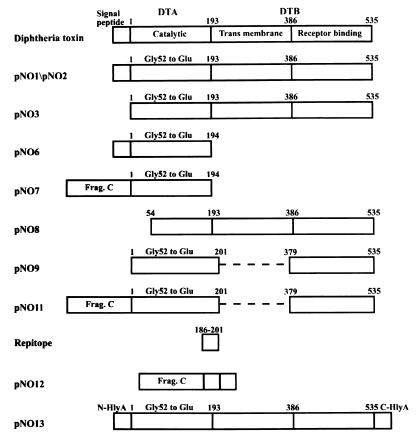FIG. 1.
Illustration of DT derivatives used in this study. The engineering of fragments encoding CRM197 or individual domains of this protein were carried out by PCR and Vent DNA polymerase (New England BioLabs, Inc., Beverly, Mass.) with the plasmid template pB197 which carries the promoter, signal sequence, and full-length mutant CRM197 structural gene. Primers used in the construction of the plasmids employed in this study are described in Table 1 and were designed by using the published sequence of the diphtheria tox gene encoded by corynebacteriophage β (10) (GenBank accession no. K01722). PCR products synthesized with Vent polymerase were then treated with Taq DNA polymerase to generate the 3′ deoxyadenosine necessary for direct cloning into the plasmid pGEM-T (Promega Corp., Madison, Wis.); recombinant plasmids were recovered by transformation into MAX Efficiency E. coli DH5α frozen competent cells (Gibco BRL, Gaithersburg, Md.). Restriction endonuclease sites incorporated into the primers were then used to subclone fragments into plasmids which were introduced into attenuated S. typhi live vector CVD 908-htrA, using electroporation as previously described (9). Detailed descriptions of the plasmids used in this work are listed in Table 2, and CRM197 derivatives generated are graphically represented. Most PCR products were subcloned into pTETnir15, either replacing the gene encoding the nontoxic fragment C of tetanus toxin or resulting in synthetic genes encoding protein fusions of fragment C and CRM197 or various subdomains. In an attempt to enhance the solubility of potentially relevant neutralizing epitopes of diphtheria toxin, a fragment encoding amino acids 186 to 201 of diphtheria toxin (1) was synthesized and fused in-frame as two copies to the carboxyl terminus of fragment C to create a repitope (14). In addition, we attempted to achieve secretion of CRM197 from CVD 908-htrA by inserting the open reading frame encoding CRM197 in-frame into the unique NsiI site of a truncated version of hlyA encoding Hemolysin A within the plasmid pMOhly (13).

